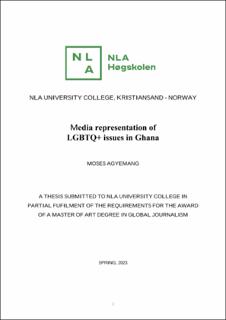| dc.description.abstract | Press accounts in Ghana reflect the prejudices against LGBTQ+ concerns. This study focused on how LGBTQ+ issues were covered in the Daily Graphic and Daily Guide newspapers in Ghana from June 1, 2021, to December 31, 2021 following the introduction of the anti-gay bill. Using a mixed research method, the objectives of the study analyzed the importance given to LGBTQ+ issues in the media, the examination of frames adopted to portray issues of LGBTQ+, and finally consider the factors that affect how media professionals cover LGBTQ+. The study drew on framing theory.
The main findings show that the two publications gave LGBTQ+ issues little prominence between June 1 and December 31, 2021. Only two of the 45 stories that were discovered within the suggested time frame—out of the total—were printed on the front page. Prominence was given in terms of story size and enhancement. Most of the stories on LGBTQ+ issues were straight news from religious leaders, politicians, and medical experts. The morality frame was used the most by the two media outlets, followed by the human-interest frame. Given the population's predominance by Muslims and Christians, this was expected.
It became apparent that most of the pieces were hard news, indicating that LGBTQ+ concerns are covered as routine stories with sparse use of more in-depth formats like features and interviews. Media professionals acknowledged that religion, culture, and the laws of Ghana have influenced their views on LGBTQ+ issues, but they nevertheless uphold their professional standards when reporting on these matters.
This article’s conclusion is that media content, framing and reporting styles all reflected the dominant views of Ghanaian society, which are opposed to LGBTQ+ issues, making it difficult for gays, lesbians, and those who support them to express their opinions through these two media outlets and constricting audiences’ perspectives on these issues.
Key words.
LGBTQ+ issues, media representation, newspapers, framing, journalists, respondents, Daily Graphic, Daily Guide. | en_US |
